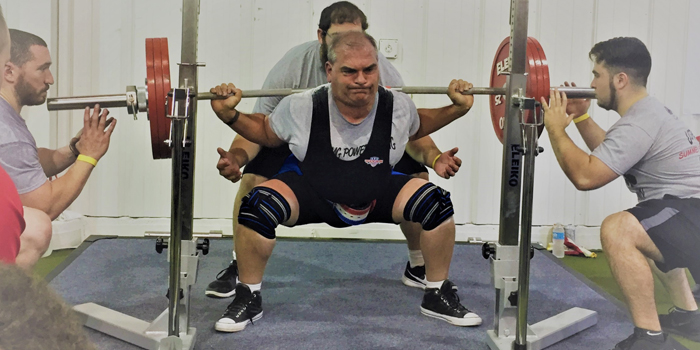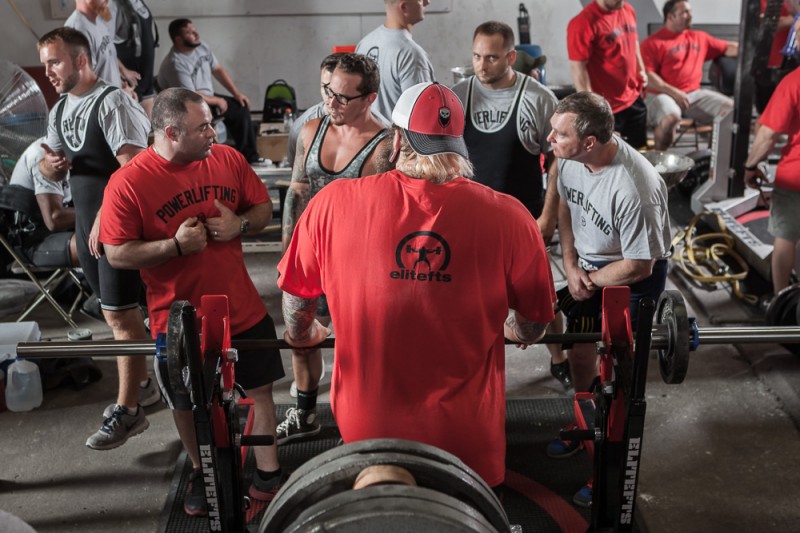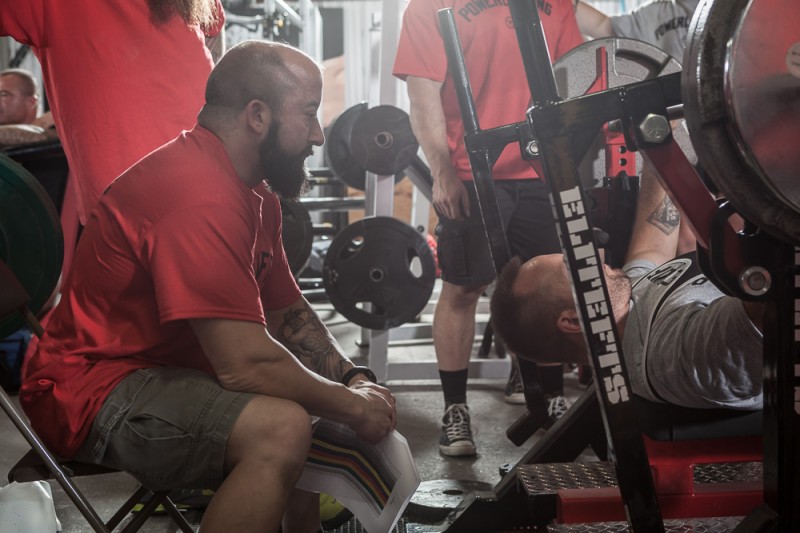
I assume that there are many of you who, for whatever reason, have left powerlifting. Some have not returned and that’s fine. Each of us must find his or her own way, and I’m sure that you are satisfied with your decision. This article, however, is especially directed at those of you who are on the fence. You are considering a return to the sport but for some reason are having difficulty pulling the trigger. My intent is to perhaps assist you in your decision, realizing that some of you may decide to stay away but sincerely hoping I can persuade enough of you to reach into your closet like I did and re-open your box of gear.
Before I detail my reasons for returning to powerlifting, I would like to recount what brought me to the sport in the first place. It was 1975 and I was attending middle school at JHS 141 in Queens, New York. On the bulletin board of the health education classroom was a Sports Illustrated centerfold depicting a photo of Arnold Schwarzenegger’s flexed right arm. That was the initial bug that bit me. I pestered my parents for years to buy me a gym membership but all I heard was “you’re not an athlete”, “why would you want to look like that”, “you can’t make money doing that”, and other such negative statements. To say I lacked support is a huge understatement.
RELATED: Comeback Programming — Returning to the Gym After An Extended Break
Not having access to a gym, I would walk to a local park after summer workdays to a set of chin-up bars and dip bars. I would do chin-ups with whatever grip I felt like that day, dips and reverse (Gironda) dips on the bars, and parallel bar pushups. I didn’t get to handle any real weights until I got to college in 1979. While there, I went to check out their gym, which was in an old factory building used by the athletic department. I started doing high bar squats and conventional deadlifts and some bench presses, overhead presses, and all kinds of other movements. I basically tried out every machine and bench they had.
I soon discovered Powerlifting USA, which at that time was only available for sale at two newsstands in the entire city of New York (one in Manhattan and one in Queens). I found myself following different programs as published in their “workout of the month” column. It didn’t click for me until I found a Mike Bridges program. I did well on his program and one day met Frank Gavin who was to become my coach and mentor. Frank was a former junior national level Olympic weightlifting competitor and, while he wasn’t a powerlifting expert, he knew enough to coach beginners and thus knew a lot more than I did at the time.
During the next 17 years, I competed in the WNPF and the ADFPA in single-ply geared lifting (raw didn’t exist). I trained at a few different gyms with two different teams and through all types of conditions and life events. Through some of those years, lifting was a constant that kept me going through difficulties. It became an extension of me, and an integral part of my identity. I didn’t total elite or win any national or world titles, but I got strong, in shape, and had a blast doing it. I was also lucky enough to escape serious injury, albeit with a few close calls.
Life, however, intervened. As it does, life threw some knuckleballs my way and I drifted away from powerlifting, which had become unable to ease the life stress I had at the time. Eventually, things turned around as they often do, and I returned to the gym after an eight-year absence.
Returning to powerlifting didn’t occur to me right away. Instead, I was into “training for health” (whatever that means). Occasionally, though, I would load some weight on the bar as if on autopilot; the lure of the iron was so great. Since my training at that time was sporadic, the aches and pains accumulated and it was obvious I needed commitment and a program. I dabbled with many different programs for a while and had some success with them but none seemed optimal for me. Finally, I fell headlong into Westside style conjugate and found that it seemed to work for me. To all the anti-Westside theorists out there, making statements like “it doesn’t work for raw”, “it doesn’t work for natural lifters", etc., I’m 56 years old, raw (I use loose knee wraps for protection), and have never touched a PED in my life. Yet after 12 weeks of Westside style programming, I added 35 pounds to my squat, 15 to my bench, and 50 to my deadlift.
But was the simple discovery of a working training system enough to enable my return to powerlifting? I tend to believe not. The more likely reason for my return, and I suspect the same reason for the sports’ allure, lies in the physical, psychological, and social benefits of competitive powerlifting.
First, powerlifting carries with it an awakening of a very primal urge to conquer nature. From the dawn of time, man has yearned to climb the highest mountain, ford the widest river, and, yes, lift the heaviest stone. This is a challenge that some of us cannot resist. Those of us drawn to this sport need this challenge to feel whole. When deprived of it, for whatever reason (self-imposed or otherwise), we feel as though we lack direction and purpose.
Next, for want of a better term, strong is better than weak. Strength, whether physical or mental, has always been valued, and those individuals who have attained exceptional strength have always been held in high esteem. Being strong sets one apart from the “average” individuals. And as Mark Bell said, “Average sucks. Don’t be average.” Nothing builds up a person’s self-esteem and physical and mental wellbeing better than attaining super strength.
Finally, powerlifting’s most redeeming quality is the degree of camaraderie displayed at competitions and seminars. Throughout my competitive years, I have met and spoken with some of the sport’s greatest lifters. At a WNPF meet in Lancaster, Pennsylvania, Gary Heisey chatted with us about local eateries. At one ADFPA Connecticut State meet, Fred Hatfield cheered us up (our team all bombed due to the flu the week before the meet) by telling lifting jokes from the old days. At one meet, Steve Scialpi improved my deadlift form in the warm-up room and handled me through the deadlifts. I subsequently trained at his gym for a year. And there were others: Chris Confessore, Ken Leistner, Ellen Stein, Joey Almodovar, Jim Cash.
WATCH: Table Talk with Dave Tate — Balancing Your Life
I ask you all: in what other sport are legends so accessible that you could basically introduce yourself to them and start a conversation and not be blown off? I have tried to understand this approachability and have surmised that truly strong people are innately humble. They don’t need to be arrogant, showy, or nasty. They see themselves as part of a greater fraternity of lifters, among which are lawyers, doctors, construction workers, housewives, tattooed bikers, ex-cons, and others of every race, religion, nationality, ethnic group, political belief, and sexual orientation, all gathered for the same purpose: to simply get strong. Again, in what other sport do you see athletes cheering on not only their competition but also the teenager in his first meet or the 75-year-old master lifter deadlifting with arthritic knees? In what other sport can you go to a meet alone and join a group of lifters who will work with you all day in the warm-up room, tightening belts, wrapping knees, and coaching you along for absolutely no reward? This to me is the undeniable magnetic draw of this sport — the environment created by the participants.
And so my saga came full circle, and after 10 years away from the platform, I returned to powerlifting at the USPA SMG Summer Throwdown, in historic Yorktown Heights, New York on August 26, 2017. I was a bit tentative at first because my lifts would not be as heavy as they were in the “old days.” Once the meet progressed, however, I rediscovered what I loved about the sport and felt at ease and at home again. In fact, my wife joked to my daughters that they should behave because “this is daddy’s church.” And we all know that you may convert, but you will always be what you are inside.
Stay strong, stay safe, and God bless.
John Backos resides in Upper Saddle River, New Jersey with his wife of 25 years and two daughters. By trade, he is an architect and works as a Construction Site Safety Coordinator in New York City. He trains at an NYSC in Ramsey, New York.











